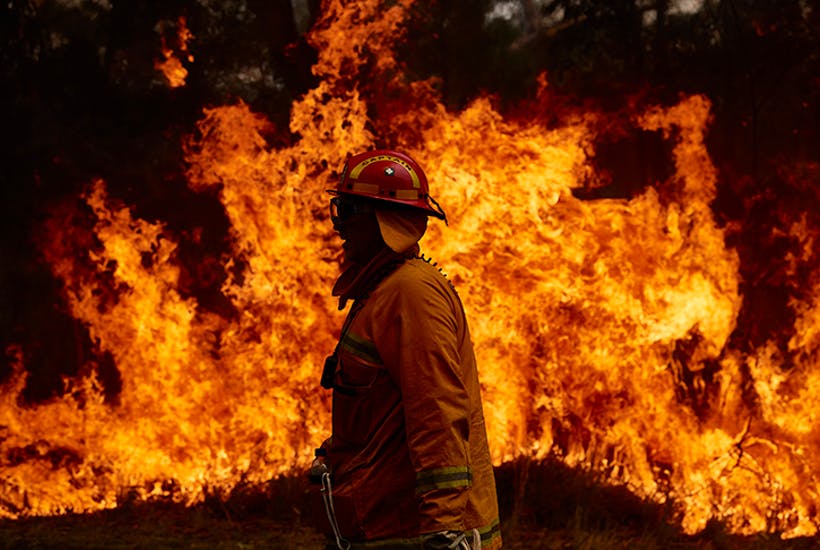Sydney
By modern standards, my grandfather would probably be considered an environmental criminal. To clear land for his farmhouse in north-eastern Victoria — and for his milking sheds, pig pens, chicken sheds, blacksmith shop and other outbuildings — he cleared hundreds of trees. And he cleared thousands more for his wheat fields, cattle paddocks and shearing sheds.
Old man Hobbs would probably be found guilty of cultural appropriation, too, because he adopted the Aboriginal method of land-clearing. He burned all of those trees. He also established fire-delaying dirt paths through surrounding bushland.
This was once standard practice throughout rural Australia, where the pre-settlement indigenous population had long conducted controlled burns of overgrown flora — known as ‘fuel’ in current fire-management talk. They knew an absence of controlled burns would invite uncontrolled burns — such as the gigantic wildfires that have ravaged much of this drought-hit nation since September.
As those fires roared through Australia’s eastern coast, killing residents and volunteer firefighters and destroying hundreds of houses, a not-unrelated court report appeared in the Sydney Morning Herald. It told the story of 71-year-old John David Chia, who in 2014 paid contractors to cut down and remove 74 trees on and around his property.
The judge in this case noted that Chia’s primary motivation for the tree removal was ‘his concern about the risk of fire at his property’, but found also the Sydney pensioner’s actions had caused ‘substantial harm’ to the environment. Chia ended up copping a $40,000 fine — more than $500 for each tree.
Similar legal rulings have become frequent in Australia, as a kind of ecological religious fundamentalism has taken the place of common sense. In 2004, Liam Sheahan was charged $100,000 in fines and legal expenses after clearing land around his hilltop property in Reedy Creek, Victoria. Five years later, that property was the only structure left standing in the area following the state’s deadly Black Saturday fires.
In 2001, electricity transmitter TransGrid sensibly bulldozed a 60-metre clearing beneath high-voltage power lines in the Snowy Mountains. The company took the view that high voltages and close-proximity combustible material is not the best combination, but duly lost $500,000 in fines and settlements paid to the New South Wales state government, which described the actions as ‘environmental vandalism’. Two years later, the journalist Miranda Devine reported that the TransGrid clearing became sanctuary for kangaroos, wallabies and three TransGrid staffers who were desperately attempting to create a wider firebreak against that year’s bushfires.
A kind of ecological religious fundamentalism has taken the place of common sense
‘We’ve been burning less than 1 per cent of our bushfire-prone land for the past 20 years,’ Brian Williams, captain of Kurrajong Heights fire brigade, told radio station 2GB recently during a brief break in his ninth week of battling a monster blaze north of Sydney. ‘That means every year the fuel load continues to build.’
Even minor attempts to reduce that fuel load are punished. Let’s suppose, for example, you have a wood fireplace at your rural house. Doing the right thing by the law and the environment, you do not cut down any trees to use as firewood. Instead, you simply collect dead branches and fallen trees lying around in the bushland dirt. This also reduces the amount of fuel available for potential bushfires, so you’re on the side of the angels.
But wait! Heed the warning from NSW National Parks and Wildlife Service Central West area manager Fiona Buchanan, in April last year: ‘We are getting the message out there that removing firewood, including deadwood and fallen trees, is not permitted in national parks. We want people to know the rules around firewood collection… It’s important people are aware that on-the-spot fines apply but also very large fines can be handed out by the courts.’
She wasn’t bluffing. A man had earlier been fined $30,000 for illegally collecting firewood in the Murrumbidgee Valley National Park. Why? Because, as Buchanan explained: ‘Many ground-dwelling animals and threatened species use tree hollows for nesting, so when fallen trees and deadwood is taken illegally, it destroys their habitat. This fallen timber is part of these animals’ natural ecosystem.’
Those natural ecosystems are now, across thousands of hectares of national parks in New South Wales, nothing but cinders and ash. Enjoy your protected habitat, little ground-dwellers.
Those woodland creatures would have been better off under the stewardship of my grandfather, whose Aboriginal-style controlled burns were not limited to his own property and its immediate surroundings. Every year he would burn the long grass growing alongside local roads to make those roads more effective as firebreaks.
He never sought permission from the local fire brigade captain to light these fires, because my grandfather happened to be the local fire brigade captain. His decisions were law, and his law was driven by an obsession to protect his family, farm animals and property from the ever-present risk of fire.
Some were not as vigilant. My mother, now in her eighties, recalls an occasion when her father loaded the entire family into the car and drove for 40 minutes or so to a nearby small town. The children assumed this was their destination, but their father kept on driving. He didn’t speak much during that trip, until eventually he slowed as the vehicle approached a newly incinerated farm. Sheep and cattle lay burned and dead in the fields. The farmhouse was a charred ruin.
‘This,’ my grandfather said, ‘is what happens if you don’t prepare for fire.’
He stayed there for a good long while, sufficient for the children to absorb his message. One of those children later took over as the local fire captain and continued his father’s careful preventive burning. Close to 100 years after he built it, my grandfather’s farmhouse is still standing. Fire has never touched it.
Tim Blair is a columnist for Australia’s Daily Telegraph.






Comments